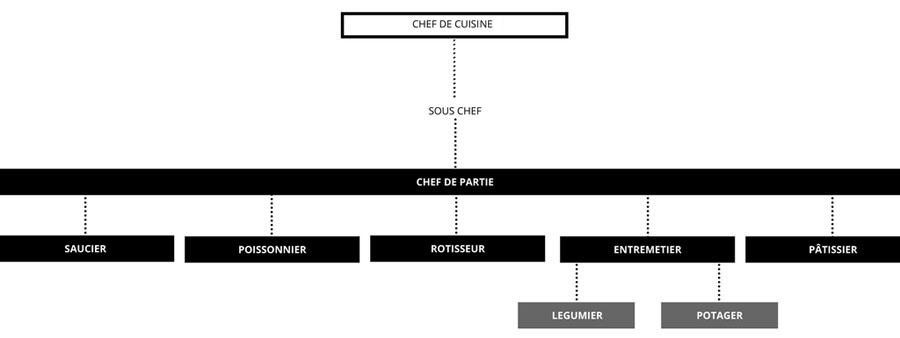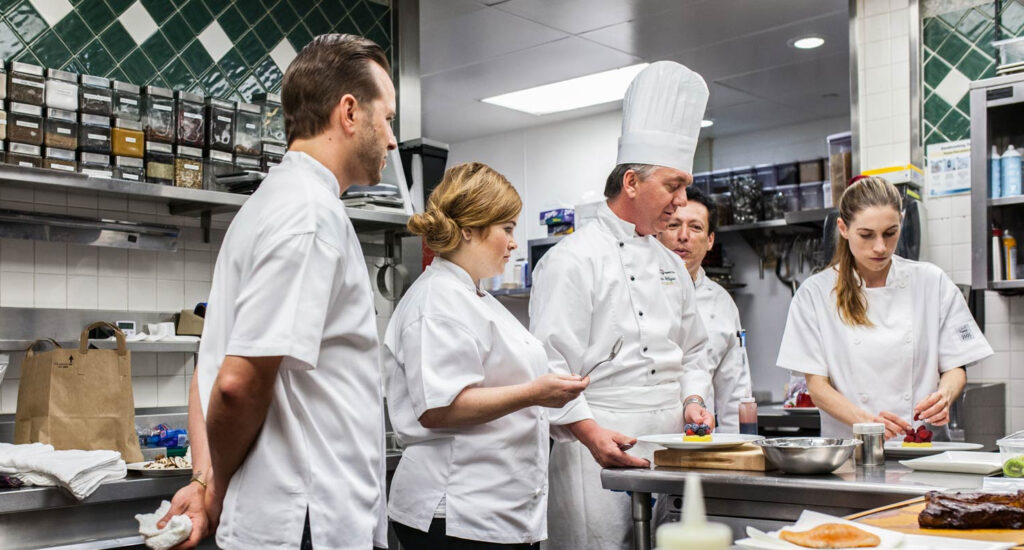Culinary Schools and restaurants are structured around modifications of the French Brigade System which organizes the kitchen staff in a hierarchy to most efficiently prepare food. Developed by Chef Auguste Escoffier in the late 1800s, the French Brigade system is based on his experience in the military where he served as chef de cuisine.
Escoffier’s system defines the hierarchy of Back of the House (BOH) positions. BOH positions are those that deal with procuring and preparing and cooking of foods and beverages, as well as the business operations. Depending on the size of the restaurant, or the depth of a school curriculum, multiple positions in the BOH hierarchy may be combined into one or eliminated altogether.
Executive Level Hierarchy
Restaurateur—The owner, proprietor or manager of a restaurant or chain of restaurants. The person who opens a new restaurant, or a new location for a restaurant chain.
Executive Chef—The executive chef is usually responsible for the operation of multiple restaurant locations. Executive chefs are also found at some of the larger, single location, restaurants.
Chief Steward—The chief steward supervises and coordinates cleanliness, inventory, staffing, banquet arrangements in hotels.
Kitchen Hierarchy
The org chart below, from Kamikoto, illustrates the hierarchy found in a typical restaurant brigade—depending on the size of a restaurant and the type of food it serves, there may be more or fewer positions in the brigade.

Chef de Cuisine (head chef) – The director or head of the kitchen. A professional cook who is also well versed in food preparation and is responsible for the “soul of the food.” Controls the whole kitchen from managing the staff, controlling the costs, creating the menus, liaising with suppliers.
Sous Chef (under chef)—Second in command. Typically, the sous chef is hands-on involved with the day-to-day running of the kitchen.
Chef de Partie (line cooks)—Responsible for running and operating a specific section, or work stations, of the kitchen.
Boucher (butcher chef)—Prepares meats and poultries.
Poissonnier (fish chef)—Prepares fish, seafood and shellfish dishes and the sauces that go with them.
Friturier (fry chef)—Prepares fried food items (deep frying).
Grillardin (grill chef)—Prepares food items that require grilling and broiling.
Garde Manger (pantry chef)—Prepares cold dishes such as salads and pates.
Charcutier (pork butcher)—Prepares pork products including pate, rillettes, hams, sausages and other cured meats.
Pâtissier (pastry chef)—Prepares baked goods, bread, pastries, pasta and desserts.
Confiseur—Prepares candies and petit fours.
Glacier—Prepares cold and frozen desserts.
Decorateur—Decorates cakes and other items
Boulanger—Baker of breads, rolls and cakes
Rotisseur (roast chef)—Prepares roasted meats (pork, beef, chicken and other game) and marinades.
Chef de Tournant (roundsman)—A swing-man who can fill in at any of the stations as needed.
Saucier (saute chef)—Creates sauces and gravies, as well as pan fried and sautéed dishes and stews.
Entremetier (vegetable chef)—Prepares vegetables, soups, stock, starches and eggs.
Potager—Prepares soups.
Legumier—Prepares vegetable dishes
Wine Steward/Sommelier—discusses, buys, pairs, and serves wine.





